Role of Bio-Based Polymers on Improving Turbulent Flow Characteristics: Materials and Application
Abstract
:1. Introduction
2. Polymer-Associated Turbulent Drag Reduction Behavior
3. Flow Geometry for Turbulence
4. Drag-Reducing Bio-Based Polymers
4.1. Natural Gum Family
4.2. λ-DNA
4.3. Amylopectin
4.4. Cellulose
4.5. Carrageenan
4.6. Okra Mucilage
5. Applications
5.1. Petroleum Industry
5.2. Biomedical Application
5.3. Flocculants
5.4. Agricultural Application
6. Conclusions
Acknowledgments
Conflicts of Interest
References
- Berezina, N.; MartellibStelter, S.M. CHAPTER 1 Bio-based polymers and materials. In Renewable Resources for Biorefineries, Valladolid, Spain, 4–6 June 2014; Cambridge: Royal Society of Chemistry: London, UK, 2014; pp. 1–28. [Google Scholar]
- Iwata, T. Biodegradable and bio-based polymers: Future prospects of eco-friendly plastics. Angew. Chem. Int. Ed. 2015, 54, 3210–3215. [Google Scholar] [CrossRef] [PubMed]
- Shephard, K. Functions for fish mucus. Rev. Fish Biol. Fish. 1994, 4, 401–429. [Google Scholar] [CrossRef]
- Sagnes, P.; Champagne, J.-Y.; Morel, R. Shifts in drag and swimming potential during grayling ontogenesis: Relations with habitat use. J. Fish. Biol. 2000, 57, 52–68. [Google Scholar] [CrossRef]
- Rosen, M.; Cornford, N.E. Fluid friction of fish slimes. Nature 1971, 234, 49–51. [Google Scholar] [CrossRef]
- Dean, B.; Bhushan, B. Shark-skin surfaces for fluid-drag reduction in turbulent flow: A review. Philos. Trans. R. Soc. A 2010, 368, 4775–4806. [Google Scholar] [CrossRef] [PubMed]
- Dosunmu, I.T.; Shah, S.N. Turbulent flow behavior of surfactant solutions in straight pipes. J. Pet. Sci. Eng. 2014, 124, 323–330. [Google Scholar] [CrossRef]
- Rollin, B.; Dubief, Y.; Doering, C.R. Variations on Kolmogorov flow: Turbulent energy dissipation and mean flow profiles. J. Fluid Mech. 2011, 670, 204–213. [Google Scholar] [CrossRef]
- Perlin, M.; Dowling, D.R.; Ceccio, S.L. Freeman scholar review: Passive and active skin-friction drag reduction in turbulent boundary layers. J. Fluids Eng. 2016, 138, 091104. [Google Scholar] [CrossRef]
- Gogto, S.; Vorobieff, R.T.; Mammoli, A.; Swol, F.; Shah, P.; Jeffrey Brinker, C. Effective slip on textured superhydrophobic surfaces. Phys. Fluids 2005, 17, 051701. [Google Scholar] [CrossRef]
- Daniello, R.J.; Waterhouse, N.E.; Rothstein, J.P. Drag reduction in turbulent flows over superhydrophobic surfaces. Phys. Fluids 2009, 21, 085103. [Google Scholar] [CrossRef]
- Toms, B.A. On the early experiments on drag reduction by polymers. Phys. Fluids 1977, 20, S3–S5. [Google Scholar] [CrossRef]
- Morgan, S.E.; Mccormick, C.L. Water-soluble copolymers XXXII: Macromolecular drag reduction. A review of predictive theories and the effects of polymer structure. Prog. Polym. Sci. 1990, 15, 507–549. [Google Scholar] [CrossRef]
- Lee, W.K.; Vaseleski, R.C.; Metzner, A.B. Turbulent drag reduction in polymeric solutions containing suspended fibers. AIChE J. 1974, 20, 128–133. [Google Scholar] [CrossRef]
- Broniarz-Press, L.; Rozanski, J.; Rozanska, S. Drag reduction effect in pipe systems and liquid falling film flow. Rev. Chem. Eng. 2007, 23, 149–245. [Google Scholar] [CrossRef]
- Boffetta, G.; Mazzino, A.; Musacchio, S.; Vozella, L. Polymer heat transport enhancement in thermal convection: The case of Rayleigh-Taylor turbulence. Phys. Rev. Lett. 2010, 104, 184501. [Google Scholar] [CrossRef] [PubMed]
- Burger, E.D.; Chorn, L.G. Studies of drag reduction conducted over a broad range of pipeline conditions when flowing Prudhoe Bay crude oil. J. Rheol. 1980, 24, 603–626. [Google Scholar] [CrossRef]
- Usui, H.; Li, L.; Suzuki, H. Rheology and pipeline transportation of dense fly ash-water slurry. Korea Aust. Rheol. J. 2001, 13, 47–54. [Google Scholar]
- Harwigsson, I.; Hellsten, M. Environmentally acceptable drag-reducing surfactants for district heating and cooling. J. Am. Oil Chem. Soc. 1996, 73, 921–928. [Google Scholar] [CrossRef]
- Mostardi, R.A.; Thomas, L.C.; Greene, H.L.; VanEssen, F.; Nokes, R.F. Suppression of atherosclerosis in rabbits using drag reducing polymers. Biorheology 1978, 15, 1–14. [Google Scholar] [PubMed]
- Kameneva, M.V.; Wu, Z.J.; Uraysh, A.; Repko, B.; Litwak, K.N.; Billiar, T.R.; Fink, M.P.; Simmons, R.L.; Griffith, B.P.; Borovetz, H.S. Blood soluble drag-reducing polymers prevent lethality from hemorrhagic shock in acute animal experiments. Biorheology 2004, 41, 53–64. [Google Scholar] [PubMed]
- Oldroyd, J.G. Suggested method of detecting wall effects on turbulent flow through tubes. Int. Rheol. Congr. 1948, 2, 130. [Google Scholar]
- Walsh, M. Theory of drag reduction in dilute high-polymer flows. Int. Shipbuild. Prog. 1967, 14, 134. [Google Scholar]
- Fontaine, A.A.; Deutsch, S.; Brungart, T.A.; Petrie, H.L.; Fenstermacker, M. Drag reduction by coupled systems: Microbubble injection with homogeneous polymer and surfactant solutions. Exp. Fluids 1999, 26, 397–403. [Google Scholar] [CrossRef]
- Metzner, A.B.; Park, M.G. Turbulent flow characteristics of viscoelastic fluids. J. Fluid Mech. 1964, 20, 291–303. [Google Scholar] [CrossRef]
- Renardy, M. On the mechanism of drag reduction. J. Non-Newton. Fluid Mech. 1995, 59, 93–101. [Google Scholar] [CrossRef]
- Kostic, M. The ultimate asymptotes and possible causes of friction drag and heat transfer phenomena. J. Eng. Heat Mass Transf. 1994, 16, 1–14. [Google Scholar]
- Lumley, J.L. Drag reduction by additives. Annu. Rev. Fluid Mech. 1969, 1, 367–384. [Google Scholar] [CrossRef]
- Tulin, M.P. Hydrodynamic aspects of macromolecular solutions. In Proceedings of the 6th Symposium on Naval Hydrodynamics, Washington, DC, USA, 28 September–4 October 1966; pp. 3–18. [Google Scholar]
- Gordon, R.J.; Balakrishnan, C. Vortex inhibition: A new viscoelastic effect with importance in drag reduction and polymer characterization. J. Appl. Polym. Sci. 1972, 16, 1629–1639. [Google Scholar] [CrossRef]
- Gadd, G.E. Reduction of turbulent drag in liquids. Nat. Phys. Sci. 1971, 230, 29–31. [Google Scholar] [CrossRef]
- Tabor, M.; De Geenes, P.G. A cascade theory of drag reduction. Europhys. Lett. 1986, 2, 519–522. [Google Scholar] [CrossRef]
- Sreenivasan, K.R.; White, C.M. The onset of drag reduction by dilute polymer additives, and the maximum drag reduction asymptote. J. Fluid Mech. 2000, 409, 149–164. [Google Scholar] [CrossRef]
- Cadot, O.; Bonn, D.; Douady, S. Turbulent drag reduction in a closed flow system: Boundary layer versus bulk effects. Phys. Fluids 1998, 10, 426–436. [Google Scholar] [CrossRef]
- Virk, P.S. Drag reduction fundamentals. AIChE J. 1975, 21, 625–656. [Google Scholar] [CrossRef]
- Benzi, R.; Angelis, E.D.; L’vov, V.S.; Procaccia, I. Identification and calculation of the universal asymptote for drag reduction by polymers in wall bounded turbulence. Phys. Rev. Lett. 2005, 95, 194502. [Google Scholar] [CrossRef] [PubMed]
- Lumley, J.L. Drag reduction in turbulent flow by polymer additives. J. Polym. Sci. Macromol. Rev. 1973, 7, 263–290. [Google Scholar] [CrossRef]
- Min, T.; Yoo, J.Y.; Choi, H.; Joseph, D.D. Drag reduction by polymer additives in a turbulent channel flow. J. Fluid Mech. 2003, 486, 213–238. [Google Scholar] [CrossRef]
- Shenoy, A.V. A review on drag reduction with special reference to micellar systems. Colloid Polym. Sci. 1984, 262, 319–337. [Google Scholar] [CrossRef]
- Abubakar, A.; Al-Wahaibi, T.; Al-Wahaibi, Y.; Al-Hashmi, A.R.; Al-Ajmi, A. Roles of drag reducing polymers in single- and multi-phase flows. Chem. Eng. Res. Des. 2014, 92, 2153–2181. [Google Scholar] [CrossRef]
- Choi, H.J.; Jhon, M.S. Polymer-Induced Turbulent Drag Reduction. Ind. Eng. Chem. Res. 1996, 35, 2993–2998. [Google Scholar] [CrossRef]
- Ricco, P.; Hahn, S. Turbulent drag reduction through rotating discs. J. Fluid Mech. 2013, 722, 267–290. [Google Scholar] [CrossRef]
- Wise, D.J.; Alvarenga, C.; Ricco, P. Spinning out of control: Wall turbulence over rotating discs. Phys. Fluids 2014, 26, 125107. [Google Scholar] [CrossRef]
- Wise, D.J.; Ricco, P. Turbulent drag reduction through oscillating discs. J. Fluid Mech. 2014, 746, 536–564. [Google Scholar] [CrossRef]
- Dickerson, J.P.; Michael Flesher, L.; Hester, R.D. A high Reynolds number rotating disk rheometer. J. Appl. Polym. Sci. 1994, 53, 151–159. [Google Scholar] [CrossRef]
- Kim, C.A.; Jo, D.S.; Choi, H.J.; Kim, C.B.; Jhon, M.S. A high-precision rotating disk apparatus for drag reduction Characterization. Polym. Test. 2000, 20, 43–48. [Google Scholar] [CrossRef]
- Sreedhar, I.; Jain, G.; Srinivas, P.; Reddy, K.S.K. Polymer induced turbulent drag reduction using pressure and gravity-driven methods. Korean J. Chem. Eng. 2014, 31, 568–573. [Google Scholar] [CrossRef]
- Subbarao, C.V.; Madhavi; Appala Naidu, D.; King, P. Use of polymer solutions for drag reduction in gravity driven flow systems. Int. J. Appl. Sci. Eng. 2013, 11, 159–169. [Google Scholar]
- Burnishev, Y.; Steinberg, V. Early turbulence in von Karman swirling flow of polymer solutions. Europhys. Lett. 2015, 109, 14006. [Google Scholar] [CrossRef]
- Eskin, D. Applicability of a Taylor-Couette device to characterization of turbulent drag reduction in a pipeline. Chem. Eng. Sci. 2014, 116, 275–283. [Google Scholar] [CrossRef]
- Mishra, A.; Malhotra, A.V. Tamarind xyloglucan: A polysaccharide with versatile application potential. J. Mater. Chem. 2009, 19, 8528–8536. [Google Scholar] [CrossRef]
- Reddy, K.; Mohan, G.K.; Satla, S.; Gaikwad, S. Natural polysaccharides: Versatile excipients for controlled drug delivery systems. Asian J. Pharm. Sci. 2011, 6, 275–286. [Google Scholar]
- Hong, C.H.; Jang, C.H.; Choi, H.J. Turbulent Drag Reduction with Polymers in Rotating Disk Flow. Polymers 2015, 7, 1279–1298. [Google Scholar] [CrossRef]
- Abdulbari, H.A.; Shabirin, A.; Abdurrahman, H.N. Bio-polymers for improving liquid flow in pipelines—A review and future work opportunities. J. Ind. Eng. Chem. 2014, 20, 1157–1170. [Google Scholar] [CrossRef]
- Tripathy, T.; Singh, R.P. Characterization of polyacrylamide-grafted sodium alginate: A novel polymeric flocculant. J. Appl. Polym. Sci. 2001, 81, 3296–3308. [Google Scholar] [CrossRef]
- Han, W.J.; Dong, Y.Z.; Choi, H.J. Applications of water-soluble polymers in turbulent drag reduction. Processes 2017, 5, 24. [Google Scholar] [CrossRef]
- Katzbauer, B. Properties and applications of xanthan gum. Polym. Degrad. Stabil. 1998, 59, 81–84. [Google Scholar] [CrossRef]
- Bewersdorff, H.W.; Singh, R.P. Rheological and drag reduction characteristics of xanthan gum solutions. Rheol. Acta 1988, 27, 617–627. [Google Scholar] [CrossRef]
- Rosalam, S.; England, R. Review of xanthan gum production from unmodified starches by Xanthomonas comprestris sp. Enzyme Microb. Technol. 2006, 39, 197–207. [Google Scholar] [CrossRef]
- Kim, C.A.; Choi, H.J.; Kim, C.B.; Jhon, M.S. Drag reduction characteristics of polysaccharide xanthan gum. Macromol. Rapid Commun. 1998, 19, 419–422. [Google Scholar] [CrossRef]
- Sohn, J.I.; Kim, C.A.; Choi, H.J.; Jhon, M.S. Drag-reduction effectiveness of xanthan gum in a rotating disk apparatus. Carbohydr. Polym. 2001, 45, 61–68. [Google Scholar] [CrossRef]
- Pereira, A.S.; Andrade, R.M.; Soares, E.J. Drag reduction induced by flexible and rigid molecules in a turbulent flow into a rotating cylindrical double gap device: Comparison between Poly(ethylene oxide), Polyacrylamide, and Xanthan Gum. J. Non-Newton. Fluid Mech. 2013, 202, 72–87. [Google Scholar] [CrossRef]
- Morris, E.R. Molecular Origin of Xanthan Solution Properties. ACS Symp. Ser. 1997, 45, 81–89. [Google Scholar]
- Norton, I.T.; Goodall, D.M.; Frangou, S.A.; Morris, E.R.; Rees, D.A. Mechanism and dynamics of conformational ordering in xanthan polysaccharide. J. Mol. Biol. 1984, 175, 371–394. [Google Scholar] [CrossRef]
- Hong, C.H.; Choi, H.J.; Zhang, K.; Renou, F.; Grisel, M. Effect of salt on turbulent drag reduction of xanthan gum. Carbohydr. Polym. 2015, 121, 342–347. [Google Scholar] [CrossRef] [PubMed]
- Malik, S.; Mashelkar, R.A. Hydrogen-bonding mediated shear stable clusters as drag reducers. Chem. Eng. Sci. 1995, 50, 105–116. [Google Scholar] [CrossRef]
- Campolo, M.; Simeoni, M.; Lapasin, R.; Soldati, A. Turbulent Drag Reduction by Biopolymers in Large Scale Pipes. J. Fluids Eng. 2015, 137, 041102. [Google Scholar] [CrossRef]
- Wang, S.; He, L.; Guo, J.; Zhao, J.; Tang, H. Intrinsic viscosity and rheological properties of natural and substituted guar gums in seawater. Int. J. Biol. Macromol. 2015, 76, 262–268. [Google Scholar] [CrossRef] [PubMed]
- Gong, H.; Liu, M.; Chen, J.; Han, F.; Gao, C.; Zhang, B. Synthesis and characterization of carboxymethyl guar gum and rheological properties of its solutions. Carbohydr. Polym. 2012, 88, 1015–1022. [Google Scholar] [CrossRef]
- Kim, C.A.; Lim, S.T.; Choi, H.J.; Sohn, J.I.; Jhon, M.S. Characterization of Drag Reducing Guar Gum in a Rotating Disk Flow. J. Appl. Polym. Sci. 2002, 83, 2938–3944. [Google Scholar] [CrossRef]
- Hong, C.H.; Zhang, K.; Choi, H.J.; Yoon, S.M. Mechanical degradation of polysaccharide guar gum under turbulent flow. J. Ind. Eng. Chem. 2010, 16, 178–180. [Google Scholar] [CrossRef]
- Zhang, L.; Zhou, J.; Hui, P.S. A comparative study on viscosity behavior of water-soluble chemically modified guar gum derivatives with different functional lateral groups. J. Sci. Food Agric. 2005, 85, 2638–2644. [Google Scholar] [CrossRef]
- Deshmukh, S.R.; Chaturvedi, P.N.; Singh, R.P. The turbulent drag reduction by graft copolymers of guargum and polyacrylamide. J. Appl. Polym. Sci. 1985, 30, 4013–4018. [Google Scholar] [CrossRef]
- Deshmukh, S.R.; Singh, R.P. Drag reduction effectiveness, shear stability and biodegradation resistance of guargum-based graft copolymers. J. Appl. Polym. Sci. 1987, 33, 1963–1975. [Google Scholar] [CrossRef]
- Behari, K.; Kumar, R.; Tripathi, M.; Pandey, P.K. Graft Copolymerization of Methacrylamide onto Guar Gum Using a Potassium Chromate/Malonic Acid Redox Pair. Macromol. Chem. Phys. 2001, 202, 1873–1877. [Google Scholar] [CrossRef]
- Bello, J.B.; Müller, A.J.; Sáez, A.E. Effect of intermolecular cross links on drag reduction by polymer solutions. Polym. Bull. 1996, 36, 111–118. [Google Scholar] [CrossRef]
- Phukan, S.; Kumar, P.; Panda, J.; Nayak, B.R.; Tiwari, K.N.; Singh, R.P. Application of drag reducing commercial and purified guargum for reduction of energy requirement of sprinkler irrigation and percolation rate of the soil. Agric. Water Manag. 2001, 47, 101–118. [Google Scholar] [CrossRef]
- Hand, J.H.; Willams, M.C. DNA and Structural Effects in Turbulent Drag Reduction. Nature 1970, 227, 369–370. [Google Scholar] [CrossRef] [PubMed]
- Choi, H.J.; Lim, S.T.; Lai, P.Y.; Chan, C.K. Turbulent Drag Reduction and Degradation of DNA. Phys. Rev. Lett. 2002, 89, 088302. [Google Scholar] [CrossRef] [PubMed]
- Lim, S.T.; Choi, H.J. λ-DNA induced turbulent drag reduction and its characteristics. Macromolecules 2003, 36, 5348–5354. [Google Scholar] [CrossRef]
- Wagner, C.; Amarouchene, Y.; Doyle, P.; Bonn, D. Turbulent Drag Reduction of polyelectrolyte solutions: Relation with the elongational viscosity. Europhys. Lett. 2003, 64, 823–829. [Google Scholar] [CrossRef]
- Bonn, D.; Amarouchene, Y.; Wagner, C.; Douady, S.; Cadot, O. Turbulent drag reduction by polymers. J. Phys. Condens. Matter 2005, 17, 1195–1202. [Google Scholar] [CrossRef]
- Lim, S.T.; Park, S.J.; Chan, C.K.; Choi, H.J. Turbulent drag reduction characteristics induced by calf-thymus DNA. Physica A 2005, 350, 84–88. [Google Scholar] [CrossRef]
- Lim, S.T.; Hong, C.H.; Choi, H.J. DNA Dynamics under turbulent flow. Macromol. Symp. 2007, 249–250, 472–477. [Google Scholar] [CrossRef]
- Stelter, M.; Wunderlich, T.; Rath, S.K.; Brenn, G.; Yarin, A.L.; Singh, R.P.; Durst, F. Shear and extensional investigations in solutions of grafted/ungrafted amylopectin and polyacrylamide. J. Appl. Polym. Sci. 1999, 77, 2773–2782. [Google Scholar] [CrossRef]
- Wunderlich, T.; Stelter, M.; Tripathy, T.; Nayak, B.R.; Brenn, G.; Yarin, A.L.; Singh, R.P.; Brunn, P.O.; Durst, F. Shear and extensional rheological investigations in solutions of grafted and ungrafted polysaccharides. J. Appl. Polym. Sci. 2000, 77, 3200–3209. [Google Scholar] [CrossRef]
- Lim, S.T.; Choi, H.J.; Biswal, D.; Singh, R.P. Turbulent drag reduction characteristics of amylopectin and its derivative. e-Polymer 2004, 4, 751–760. [Google Scholar] [CrossRef]
- Interthal, W.; Wilski, H. Drag reduction experiments with very large pipes. Colloid Polym. Sci. 1985, 263, 217–229. [Google Scholar] [CrossRef]
- Deshmukh, S.R.; Sudhakar, K.; Singh, R.P. Drag-reduction efficiency, shear stability, and biodegradation resistance of carboxymethyl cellulose-based and starch-based graft copolymers. J. Appl. Polym. Sci. 1991, 43, 1091–1101. [Google Scholar] [CrossRef]
- Biswal, D.R.; Singh, R.P. Characterisation of carboxymethyl cellulose and polyacrylamide graft copolymer. Carbohydr. Polym. 2004, 57, 379–387. [Google Scholar] [CrossRef]
- Hoyt, J.W. Drag reduction in polysaccharide solutions. Trends Biotechnol. 1985, 3, 17–21. [Google Scholar] [CrossRef]
- Bushnell, D.M. Viscous Drag Reduction in Boundary Layers; The American Institute of Aeronautics and Astronautics, Inc.: Washington, WA, USA, 1990; pp. 416–418. [Google Scholar]
- Mishra, M.M.; Yadav, M.; Sand, A.; Tripathy, J.; Behari, K. Water soluble graft copolymer (κ-carrageenan-g-N-vinyl formamide): Preparation, characterization and application. Carbohydr. Polym. 2010, 80, 235–241. [Google Scholar] [CrossRef]
- Yadav, M.; Sand, A.; Mishra, M.M.; Tripathy, J.; Pandey, V.S.; Behari, K. Synthesis, characterization and applications of graft copolymer (κ-carrageenan-g-vinylsulfonic acid). Int. J. Biol. Macromol. 2012, 50, 826–832. [Google Scholar] [CrossRef] [PubMed]
- Abdul Bari, H.A.; Rosli, M.Y.; Ahmad, M.A. Studying the Effect Addition of Okra-Natural Mucilage as Drag Reducing Agent in Different Size of Pipes in Turbulent Water Flowing System. In Proceedings of the National Conference on Postgraduate Research (NCON-PGR), Pahang, Malaysia, 1 October 2009. [Google Scholar]
- Abdulbari, H.A.; Kamarulizam, S.N.; Man, R.C. Investigating drag reduction characteristic using okra mucilage as new drag reduction agent. J. Appl. Sci. 2011, 11, 2554–2561. [Google Scholar]
- Abdulbari, H.A.; Kamarulizam, N.S.; Nour, A.H. Grafted natural polymer as new drag reducing agent: An experimental approach. Chem. Ind. Chem. Eng. 2012, 18, 361–371. [Google Scholar] [CrossRef]
- Coelho, E.C.; Barbosa, K.C.O.; Soares, E.J.; Siqueira, R.N.; Freitas, J.C.C. Okra as a drag reducer for high Reynolds numbers water flows. Rheol. Acta 2016, 55, 983–991. [Google Scholar] [CrossRef]
- Abdulbari, H.A.; Letchmanan, K.; Yunus, R.M. Drag reduction characteristics using aloe vera natural mucilage: An experimental study. J. Appl. Sci. 2011, 1–5. [Google Scholar]
- Abdulbari, H.A.; Mohamad, N.K.; Mohd, N.; Nour, A.H. Effect of chitosan solution in turbulent drag reduction in aqueous media flow. Sci. Res. Essays 2011, 6, 3058–3064. [Google Scholar]
- Lu, C.; Lukach, C.A.; Pas, R.R. Carboxymethyl Guar Based Drilling Fluids. U.S. Patent 4,743,384A, 10 May 1988. [Google Scholar]
- Mortazavi, S.M.M. Correlation of polymerization conditions with drag reduction efficiency of poly(1‑hexene) in oil pipelines. Iran Polym. J. 2016, 25, 731–737. [Google Scholar] [CrossRef]
- Wang, Z.H.; Yu, X.Y.; Li, J.X.; Wang, J.G.; Zhang, L. The use of biobased surfactant obtained by enzymatic syntheses for wax deposition inhibition and drag reduction in crude Oil Pipelines. Catalysts 2016, 6, 61. [Google Scholar] [CrossRef]
- Taylor, K.C.; Nasr-El-Din, H.A. Water-soluble hydrophobically associating polymers for improved oil recovery: A literature review. J. Pet. Sci. Eng. 1998, 19, 265–280. [Google Scholar] [CrossRef]
- Wever, D.A.Z.; Picchioni, F.; Broekhuis, A.A. Polymers for enhanced oil recovery: A paradigm for structure–property relationship in aqueous solution. Prog. Polym. Sci. 2011, 36, 1558–1628. [Google Scholar] [CrossRef]
- Thombarea, N.; Jhab, U.; Mishrab, S.; Siddiqui, M.Z. Guar gum as a promising starting material for diverse applications: A review. Int. J. Biol. Macromol. 2016, 88, 361–372. [Google Scholar] [CrossRef] [PubMed]
- Singh, A.V.; Singh, R. Synthesis, characterization and rheological properties of guaran grafted polystyrene (G-G-PS) copolymer. J. Eng. Sci. Manag. Educ. 2010, 3, 47–51. [Google Scholar]
- Melbouci, M.; Nguyen, T.T.; Young, T. Oxidized Guar for Oilfield Servicing Fluids. U.S. Patent 7,851,416, 14 December 2012. [Google Scholar]
- Hodge, R.M. Particle Transport Fluids Thickened with Acetylate Free Xanthan Heteropolysaccharide Biopolymer Plus Guar Gum. U.S. Patent 5,591,699, 7 January 1997. [Google Scholar]
- Sakai, T.; Repko, B.; Griffith, B.P.; Waters, J.H.; Kameneva, M.V. IV infusion of a drag-reducing polymer extracted from aloe vera prolonged survival time in a rat model of acute myocardial ischaemia. Br. J. Anaesth. 2007, 98, 23–28. [Google Scholar] [CrossRef] [PubMed]
- Macias, C.A.; Kameneva, M.V.; Tenhunen, J.J.; Puyana, J.; Fink, M.P. Survival in a rat model of lethal hemorrhagic shock is prolonged following resuscitation with a small volume of a solution containing a drag-reducing polymer derived from aloe vera. Shock 2004, 22, 151–156. [Google Scholar] [CrossRef] [PubMed]
- Greene, H.L.; Mostardi, R.F.; Nokes, R.F. Effects of drag reducing polymers on initiation of atherosclerosis. Polym. Eng. Sci. 1980, 20, 499–504. [Google Scholar] [CrossRef]
- Polimeni, P.I.; Ottenbreit, B.; Coleman, P. Enhancement of aortic blood flow with a linear anionic macropolymer of extraordinary molecular length. J. Mol. Cell. Cardiol. 1985, 17, 72l–724. [Google Scholar] [CrossRef]
- Singh, R.P.; Karmakar, G.P.; Rath, S.K.; Karmakar, N.C.; Pandey, S.R.; Tripathy, T.; Panda, J.; Wan, K.; Jain, S.K.; Lan, N.T. Biodegradable drag reducing agents and flocculants based on polysaccharides: Materials and applications. Polym. Eng. Sci. 2000, 40, 46–60. [Google Scholar] [CrossRef]
- Singh, R.P.; Singh, J.; Deshmukh, S.R.; Kumar, D.; Kumar, A. Application of drag-reducing polymers in agriculture. Curr. Sci. 1995, 68, 631–641. [Google Scholar]





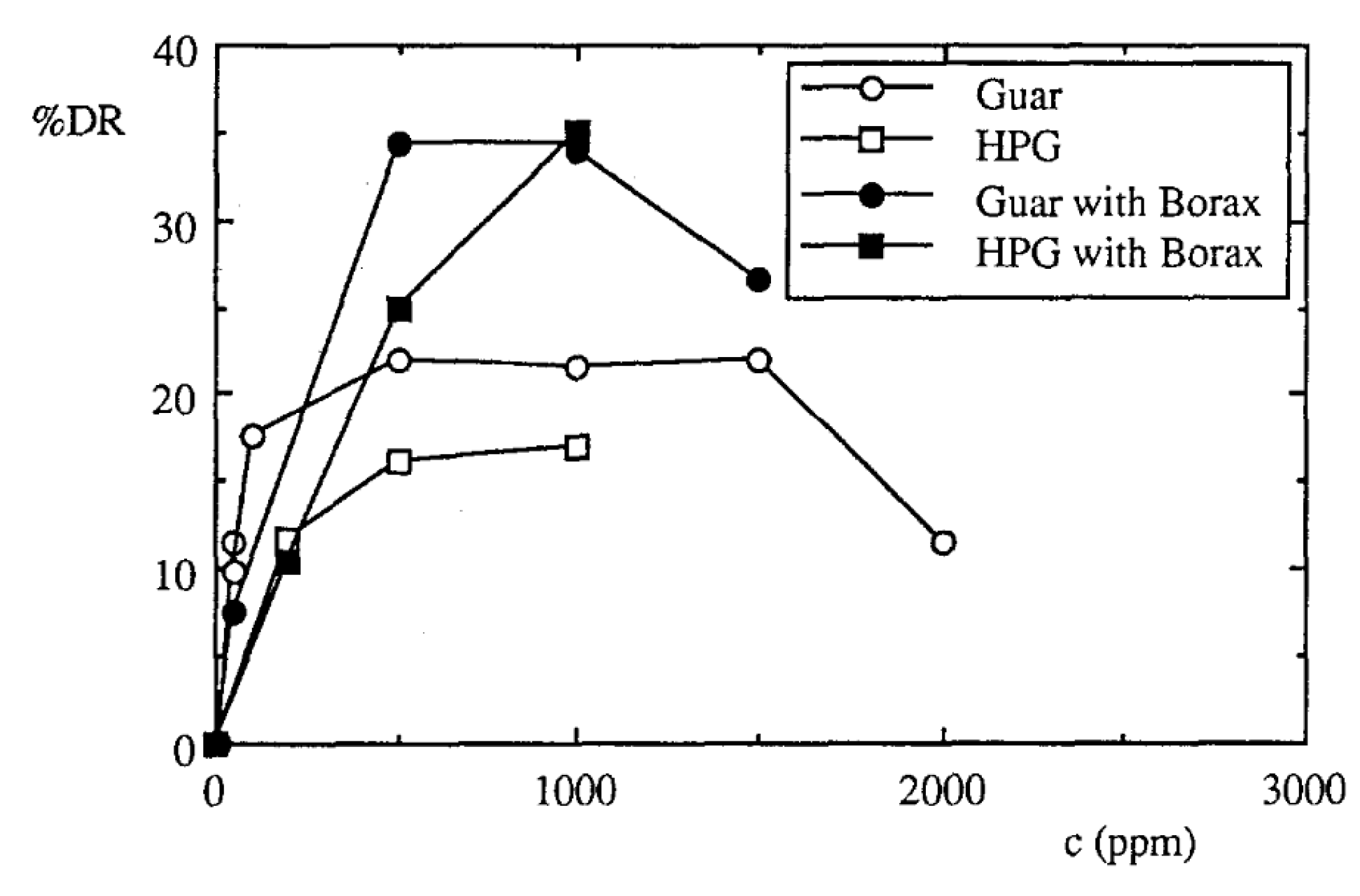
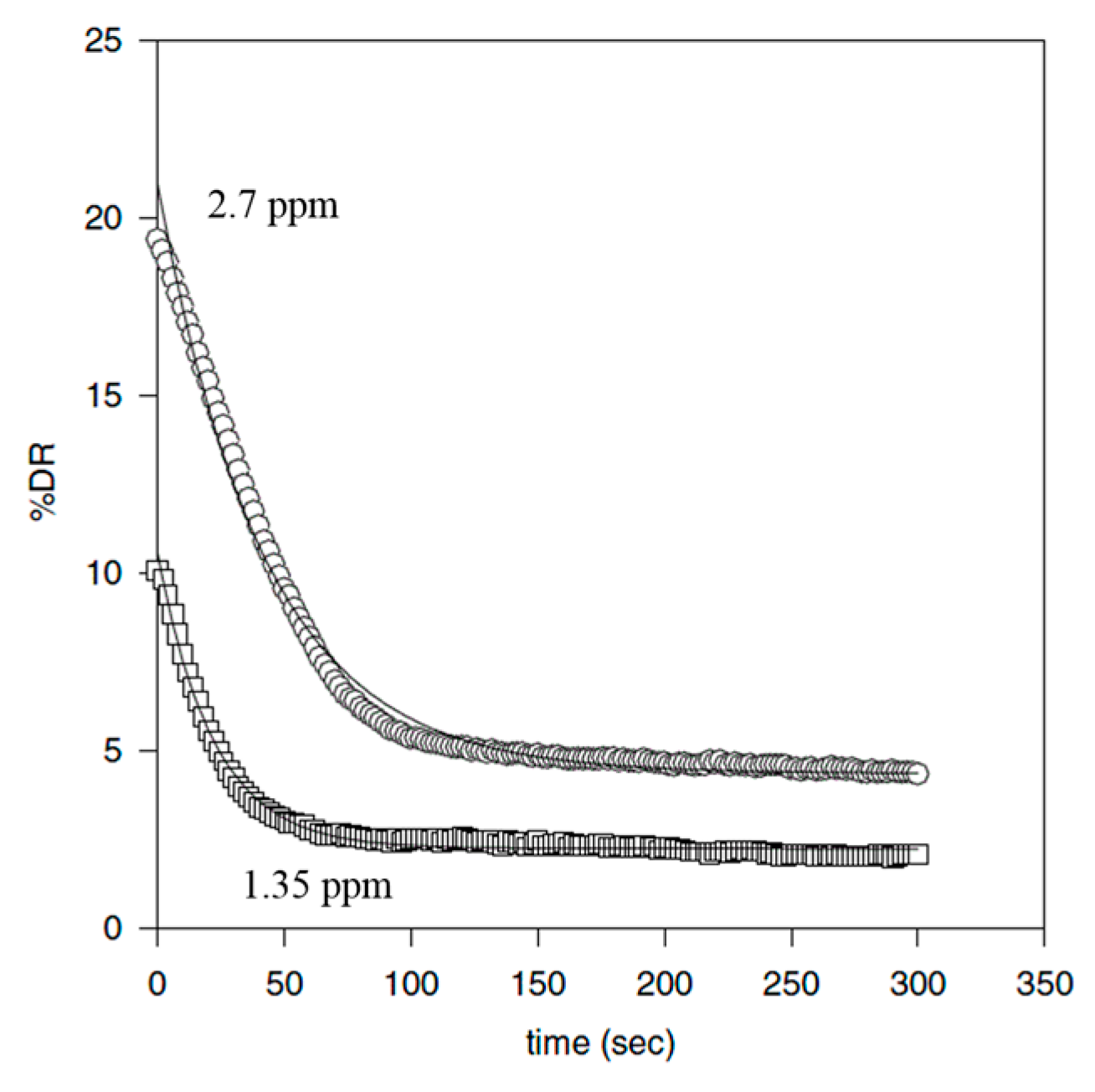
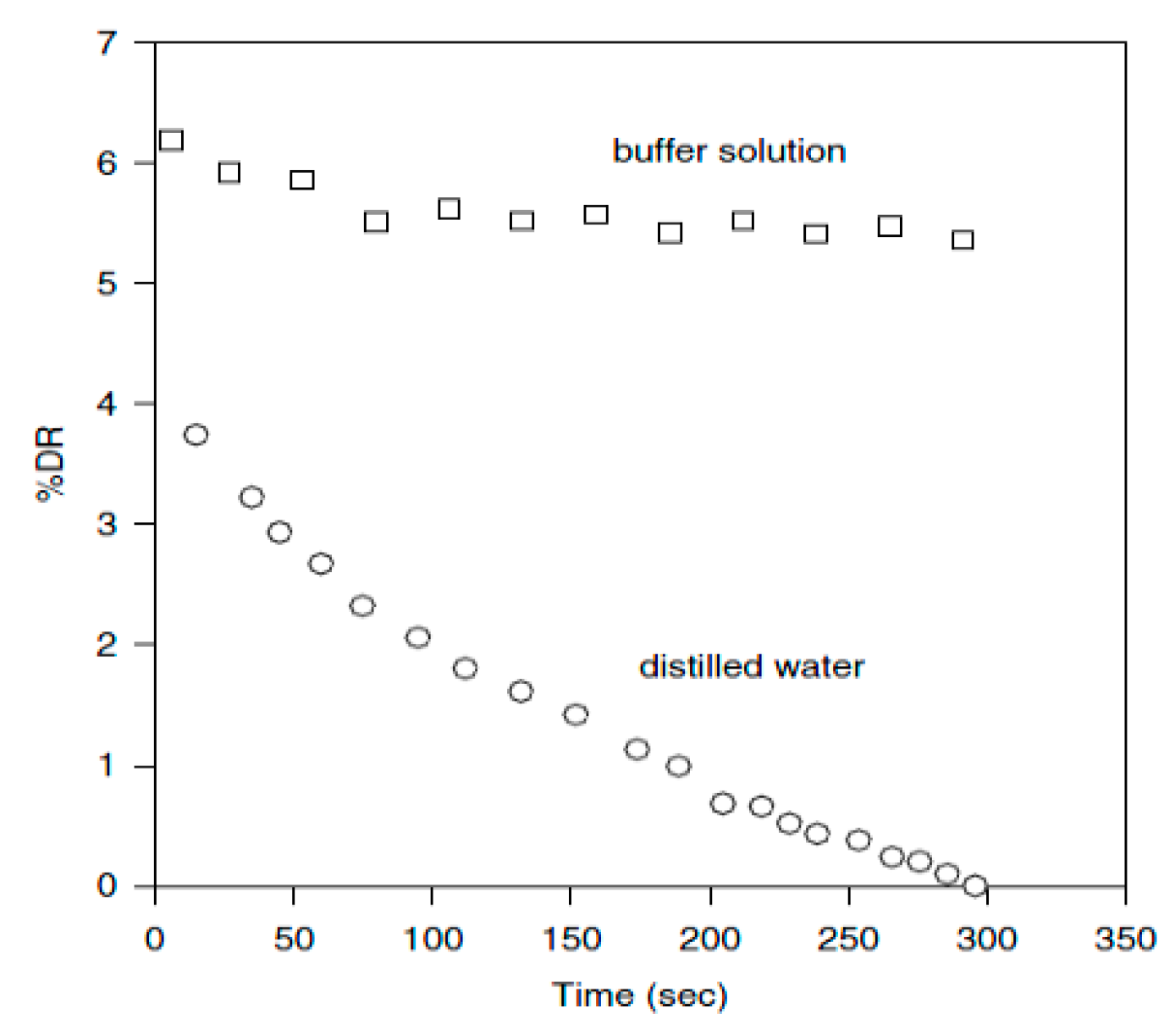
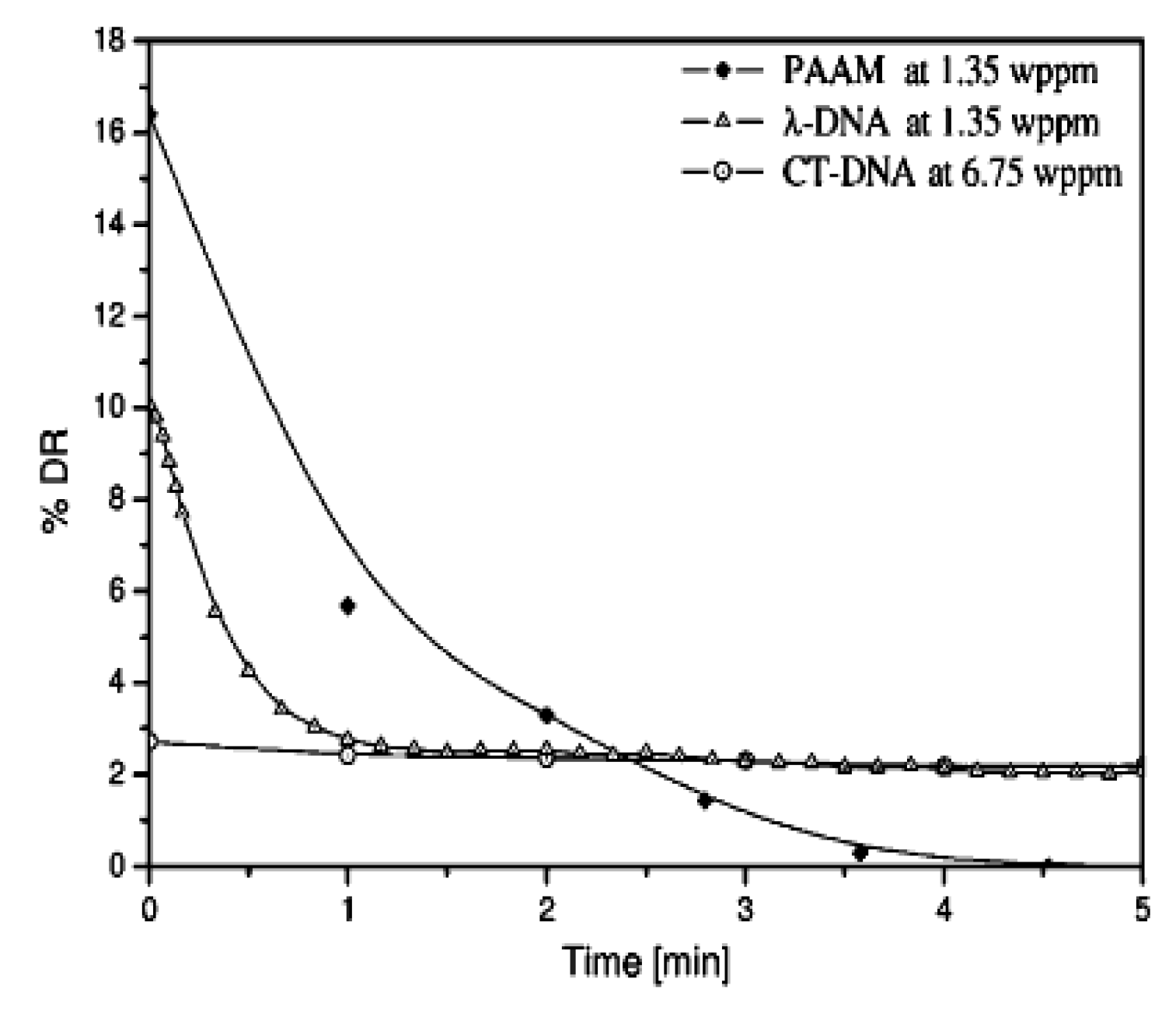

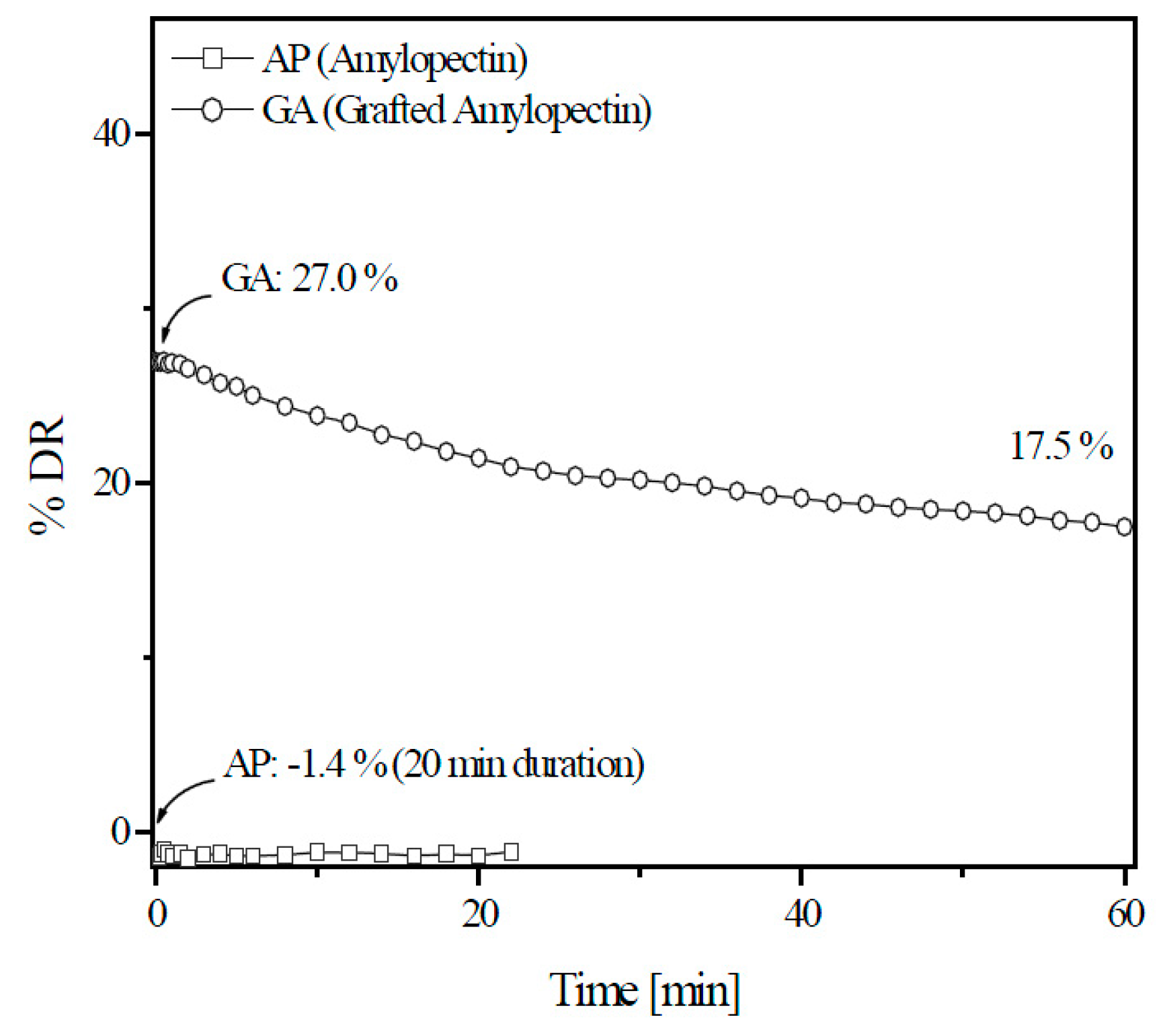
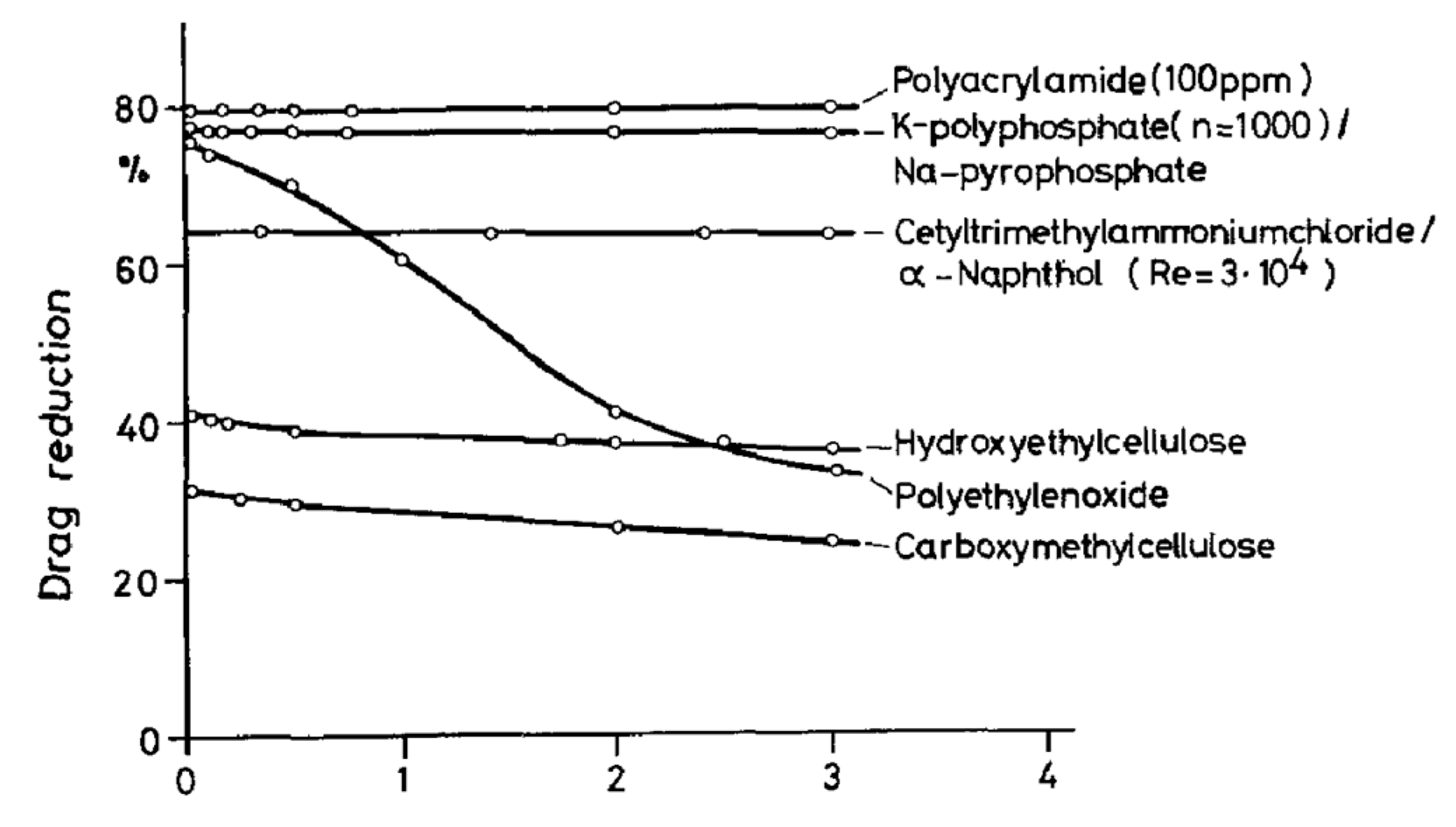


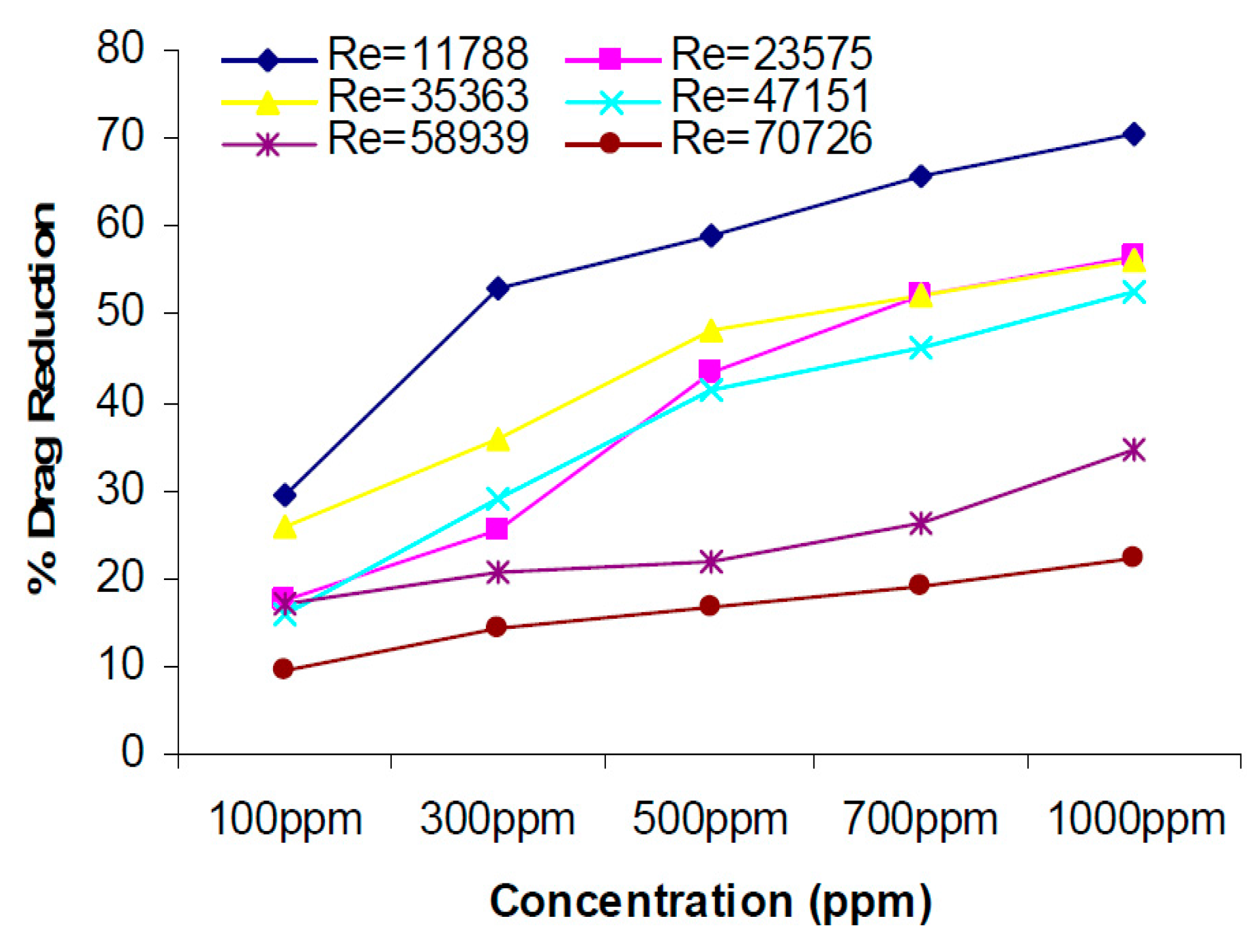

| Biopolymer | Solvent | Concentration (ppm) | Max DR% |
|---|---|---|---|
| Xanthan gum [66] | Water | 200 | 36.2 |
| Xanthan gum [66] | Water and KCl | 200 | 34 |
| Xanthan gum [62] | Water and NaCl | 200 | 33 |
| Guar gum [71] | Water | 200 | 32 |
| λ-DNA [79] | Water | 2.7 | 19.8 |
| CT-DNA [84] | Water | 20.25 | 5.8 |
| Amylopectin [87] | Water | 30 | 27.3 |
| Hydroxyethyl cellulose [88] | Water | 300 | 42 |
| Carboxymethyl cellulose [89] | Water | 1000 | 42 |
| Carrageenan [93] | Water | 2000 | 60 |
| Okra [95] | Water | 1000 | 71 |
| Aloe vera [99] | Water | 400 | 63 |
| Chitosan [100] | Water | 300 | 80.4 |
© 2017 by the authors. Licensee MDPI, Basel, Switzerland. This article is an open access article distributed under the terms and conditions of the Creative Commons Attribution (CC BY) license (http://creativecommons.org/licenses/by/4.0/).
Share and Cite
Han, W.J.; Choi, H.J. Role of Bio-Based Polymers on Improving Turbulent Flow Characteristics: Materials and Application. Polymers 2017, 9, 209. https://doi.org/10.3390/polym9060209
Han WJ, Choi HJ. Role of Bio-Based Polymers on Improving Turbulent Flow Characteristics: Materials and Application. Polymers. 2017; 9(6):209. https://doi.org/10.3390/polym9060209
Chicago/Turabian StyleHan, Wen Jiao, and Hyoung Jin Choi. 2017. "Role of Bio-Based Polymers on Improving Turbulent Flow Characteristics: Materials and Application" Polymers 9, no. 6: 209. https://doi.org/10.3390/polym9060209






